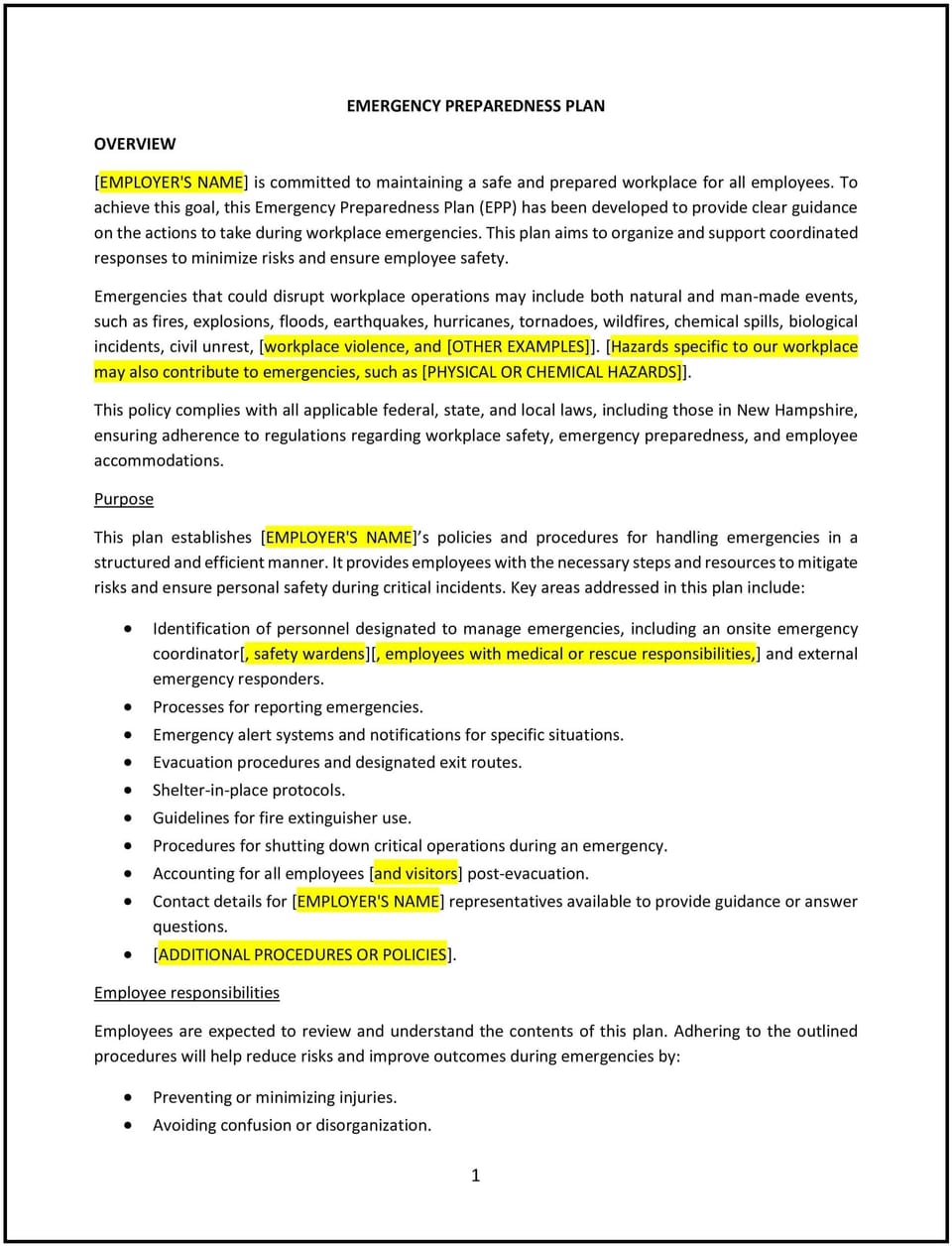Emergency preparedness plan (New Hampshire): Free template

Emergency preparedness plan (New Hampshire)
An emergency preparedness plan helps New Hampshire businesses respond effectively to emergencies, such as natural disasters, fires, medical emergencies, or other crises. This policy outlines procedures for ensuring the safety and well-being of employees, customers, and visitors during emergency situations, as well as strategies for minimizing business disruption.
By implementing this plan, businesses in New Hampshire can be better prepared for emergencies, mitigate risks, and ensure that employees understand their roles and responsibilities during critical situations.
How to use this emergency preparedness plan (New Hampshire)
- Assess potential risks: Identify the types of emergencies that could impact the business, such as severe weather, fire, workplace violence, medical emergencies, or active shooter situations, and prepare for each accordingly.
- Develop response procedures: Outline the steps employees should take in the event of an emergency, including evacuation routes, emergency contact information, first aid procedures, and instructions for securing sensitive company assets.
- Assign roles and responsibilities: Designate emergency response teams or key personnel who will be responsible for managing the emergency response, ensuring the safety of others, and coordinating with authorities.
- Create communication protocols: Establish a clear communication plan to ensure that employees, customers, and visitors are informed of the emergency situation, including how to communicate during an emergency (e.g., using intercom systems, mobile alerts, or email).
- Provide training and drills: Regularly train employees on emergency response procedures, conduct drills, and evaluate the effectiveness of the plan to ensure everyone knows what to do in case of an emergency.
- Prepare emergency supplies: Stock essential emergency supplies, such as first aid kits, fire extinguishers, flashlights, backup power sources, and non-perishable food or water, depending on the nature of the potential emergency.
- Review and update: Review the plan periodically, especially after incidents or changes in regulations, and update it to reflect new risks, technologies, or business needs.
Benefits of using this emergency preparedness plan (New Hampshire)
This plan provides several benefits for New Hampshire businesses:
- Enhances employee safety: A well-defined emergency preparedness plan ensures that employees know how to respond to emergencies, helping to minimize injuries and fatalities during a crisis.
- Reduces business disruptions: By preparing for potential emergencies, businesses can minimize operational interruptions, ensuring that they can continue or quickly resume operations after a crisis.
- Improves response time: Clear roles, responsibilities, and communication protocols allow businesses to respond swiftly and efficiently in an emergency situation, reducing confusion and panic.
- Demonstrates commitment to employee well-being: Businesses that prioritize emergency preparedness show that they care about the health, safety, and security of their employees, which can improve employee morale and trust.
- Helps businesses comply with regulations: Many industries require businesses to have emergency preparedness plans in place. This plan can help ensure compliance with local, state, or federal regulations.
Tips for using this emergency preparedness plan (New Hampshire)
- Communicate the plan effectively: Ensure that all employees are familiar with the emergency preparedness plan, understand their roles in an emergency, and know where to access the necessary resources (e.g., evacuation maps, emergency contacts).
- Conduct regular drills: Regularly hold emergency drills to test the effectiveness of the plan and make adjustments based on the lessons learned.
- Involve employees in planning: Encourage employees to provide input on the emergency plan, especially those who may have valuable knowledge of the specific risks associated with their roles.
- Keep contact information updated: Ensure that employee, emergency responder, and key personnel contact information is updated and readily available during an emergency.
- Create a business continuity plan: Pair the emergency preparedness plan with a business continuity plan to ensure the business can recover and resume operations after an emergency.
- Review the plan periodically: Review and update the plan regularly to ensure it remains effective and incorporates new risks or best practices for emergency response.
Q: Why should New Hampshire businesses have an emergency preparedness plan?
A: Businesses should implement an emergency preparedness plan to protect employees, customers, and visitors during emergencies, minimize business disruptions, and comply with regulatory requirements for workplace safety.
Q: What types of emergencies should businesses prepare for?
A: Businesses should prepare for a range of potential emergencies, including natural disasters, fires, medical emergencies, workplace violence, and active shooter situations, based on the specific risks in their region or industry.
Q: How can businesses train employees for emergency situations?
A: Businesses should provide regular training on emergency procedures, conduct drills, and ensure that employees understand their roles and responsibilities in different emergency scenarios.
Q: What emergency supplies should businesses keep on hand?
A: Businesses should stock essential emergency supplies, such as first aid kits, fire extinguishers, backup power sources, flashlights, non-perishable food and water, and any other equipment relevant to the specific emergencies they may face.
Q: What if an employee cannot participate in emergency drills due to a medical condition?
A: Businesses should make accommodations for employees with medical conditions, such as providing alternative means for participation or adjusting drills to ensure everyone is included without compromising their health.
Q: How often should businesses review and update their emergency preparedness plan?
A: Businesses should review their emergency preparedness plan at least once a year, or more frequently if there are significant changes in business operations, risks, or regulations that require updates.
Q: What should businesses do if an emergency occurs?
A: Businesses should follow their emergency preparedness plan by activating response procedures, ensuring employee safety, communicating with stakeholders, and coordinating with emergency services or authorities as necessary.
This article contains general legal information and does not contain legal advice. Cobrief is not a law firm or a substitute for an attorney or law firm. The law is complex and changes often. For legal advice, please ask a lawyer.


